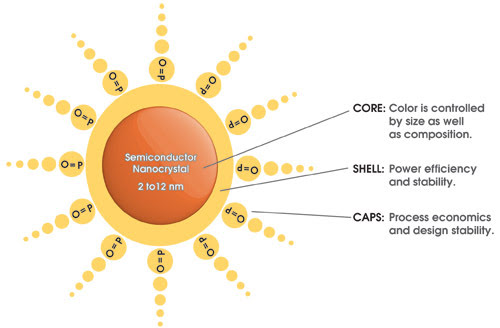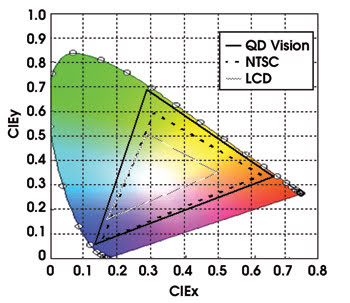Dr. Daniel P. Button and Dr. Seth Coe-Sullivan, QD Vision Inc.
In the lighting and display product markets, the buzz has been about LEDs, which have experienced dramatic changes in the past several years and which continue to push aggressively forward.
The hot topic is organic LEDs (OLEDs) and their promise to deliver improvements for both lighting and display. In the past year, the first products have made their way into retail outlets to generally favorable reviews. One of the highest-profile OLED product announcements was Sony’s XEL-1, an 11-in. television that has been praised for its thinness and bright, vivid images. However, at a cost of around $2,500 in the US, it remains out of reach for most consumers.
Samsung, which recently rolled out the largest OLED television at 31 in., predicts that it will begin commercial production of large- and mid-size versions in 2010. Besides televisions, OLED displays have found their way onto numerous products, including cell phones and portable devices, keyboards and digital photo frames.
What makes OLEDs so attractive?
• OLED TVs require no backlight, reducing energy use.
• They use only a single glass substrate and no backlight unit assembly or polarizer films, enabling extremely thin displays.
• They have a fast response time, eliminating motion blur.
• OLEDs deliver a richer range of colors than existing technologies.
Although they promise significant advances in display and lighting performance, a couple of key problems with this fragile chemistry must be overcome. No. 1 – and the main sticking point – is that OLED panel manufacturing is still an inefficient process. The larger the screen size, the larger the yield and manufacturing losses, especially for higher resolution formats. And even though they are finding their way onto mobile phones and other personal devices, manufacturers still must improve their efficiency.
A second major issue is material lifetime, especially for products such as televisions.

Quantum dots are directly emissive. Moreover, they are inorganic materials that are inherently stable.
Nanotechnology to the rescue
So, as OLED products begin to hit the market, researchers are moving rapidly ahead with a nanotechnology-based solution that could leapfrog OLEDs in terms of color, efficiency and manufacturability. Called quantum dot LEDs (QD-LEDs), the technology is beginning to emerge from the laboratory and soon will be hitting the market. Quantum dots are a new class of inorganic nanomaterials that can be engineered to be extremely stable. They promise step changes in color performance, power efficiency, manufacturing versatility and design flexibility, while being poised to address perceived practical weaknesses in OLEDs regarding stability, scalability and cost.

Quantum dots can produce better color than OLEDs and LEDs. They have highly saturated, vivid and pure color, are precisely tunable and are the only emitters that can span the spectrum, including deep reds and greens.
Just what is a QD-LED, and what will its impact be on the display and lighting industries?
The QD-LED is a printable, thin-film electroluminescent technology that delivers exceptional color, material stability and high-power efficiency at a low manufacturing cost, making it the optimal solution for both display and solid-state-lighting applications.
Several key features of quantum dots enable LED technology to be taken to the next level:
• Quantum dots permit the combination of the soluble nature and processability of organic dyes with the high efficiency and stability of inorganic semiconductors.
• They are more stable in the presence of water vapor and oxygen than their organic semiconductor counterparts.
• Their luminescence is extremely narrowband and yields highly saturated color emission.
• Fine-tuning of the absorption and emission wavelengths can be achieved through synthesis and structural changes, facilitating the process for identifying and optimizing luminescent properties.
Color, power and design benefits
Because quantum dot materials emit pure, finely tuned colors, they provide better color saturation and color rendering than any other available technology. They also use less power than other solutions, making them an attractive option for clean-technology applications. LCDs, for example, use white backlighting filtered to achieve desired colors, consuming up to 10 times the power of quantum dot-based displays, which emit light and color directly.
Quantum dot inks can be applied to virtually any substrate using a wide range of well-known printing and coating techniques. This opens up possibilities in the design and manufacture of consumer and industrial products, including the potential for extremely thin flexible displays and for very large format displays and signage.
Besides being designed into new lighting and display products, QD-LEDs also can work with other LED/LCD technologies to improve performance in existing products. For example, the technology can be used to deliver color conversion for LCD- and OLED-based displays, further enhancing color with significant savings in power and cost.
The debut of the first OLED products already has generated significant excitement. Continued improvement in the technology, plus the rapidly advancing work in QD-LEDs, promise in the not-too-distant future new levels of performance and efficiency for products in the display and solid-state-lighting industries.
Meet the authors
Daniel P. Button is chief executive officer of QD Vision Inc. in Watertown, Mass.; e-mail: [email protected].
Seth Coe-Sullivan is chief technology officer and co-founder of QD Vision; e-mail: [email protected].